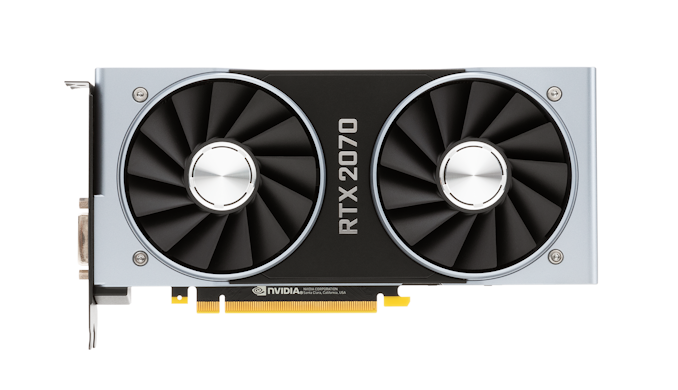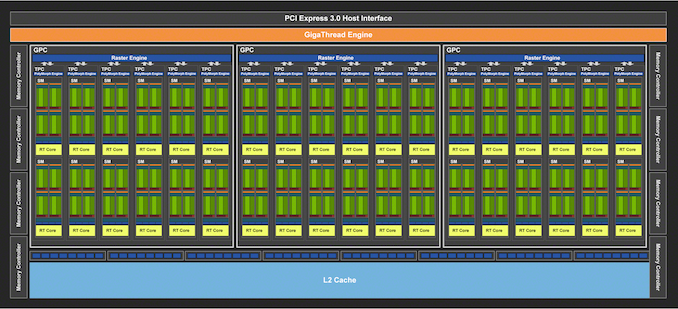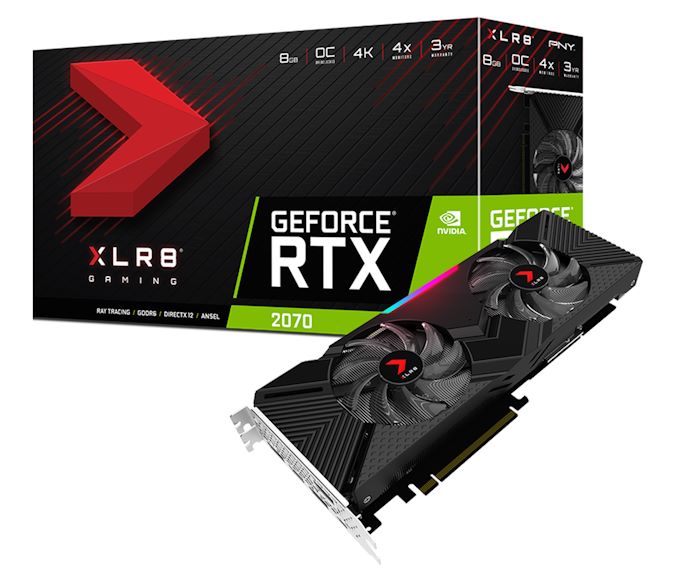The NVIDIA GeForce RTX 2070 Founders Edition Review: Mid-Range Turing, High-End Price
by Nate Oh on October 16, 2018 9:00 AM EST
When NVIDIA first announced their Turing based GeForce RTX 20 series, they unveiled three GeForce RTX models: the 2080 Ti, 2080, and 2070. As we’ve seen earlier, Turing and the GeForce RTX 20 series as a whole are designed on a hardware and software level to enable realtime raytracing for games, as well as other new specialized features, though all of these are yet to launch in games. Nevertheless, last month’s release of the GeForce RTX 2080 Ti and 2080 finally revealed their places on the traditional performance spectrum. As the ‘value’ oriented enthusiast offering, the RTX 2070 is arguably the more important card for most prospective buyers. And so, ahead of tomorrow’s launch, today we take a look at the GeForce RTX 2070 Founders Edition.
Even as the value option, which is historically the case for the x70 part, the RTX 2070 Founders Edition comes in at $599, with standard MSRP at $499. For all intents and purposes, the lower $499 price won’t be seen in the near-future as AIBs will be aligned with NVIDIA to avoid cannibalization and lower ASPs. Either way, the $500 mark makes it clear that ‘value’ and ‘cheap’ don’t necessarily mean the same thing.
| NVIDIA GeForce Specification Comparison | ||||||
| RTX 2070 Founder's Edition |
RTX 2070 | GTX 1070 | RTX 2080 | |||
| CUDA Cores | 2304 | 2304 | 1920 | 2944 | ||
| ROPs | 64 | 64 | 64 | 64 | ||
| Core Clock | 1410MHz | 1410MHz | 1506MHz | 1515MHz | ||
| Boost Clock | 1710MHz | 1620MHz | 1683MHz | 1710MHz FE: 1800MHz |
||
| Memory Clock | 14Gbps GDDR6 | 14Gbps GDDR6 | 8Gbps GDDR5 | 14Gbps GDDR6 | ||
| Memory Bus Width | 256-bit | 256-bit | 256-bit | 256-bit | ||
| VRAM | 8GB | 8GB | 8GB | 8GB | ||
| Single Precision Perf. | 7.9 TFLOPs | 7.5 TFLOPs | 6.5 TFLOPs | 10.1 TFLOPs | ||
| "RTX-OPS" | 45T | 45T | N/A | 60T | ||
| SLI Support | No | No | Yes | Yes | ||
| TDP | 185W | 175W | 150W | 215W FE: 225W |
||
| GPU | TU106 | TU106 | GP104 | TU104 | ||
| Transistor Count | 10.8B | 10.8B | 7.2B | 13.6B | ||
| Architecture | Turing | Turing | Pascal | Turing | ||
| Manufacturing Process | TSMC 12nm "FFN" | TSMC 12nm "FFN" | TSMC 16nm | TSMC 12nm "FFN" | ||
| Launch Date | 10/17/2018 | N/A | 06/10/2016 | 09/20/2018 | ||
| Launch Price | $599 | $499 | MSRP: $379 Founders $449 |
MSRP: $699 Founders $799 |
||
For the RTX 2070, its value would be measured by both traditional rasterization performance, and hybrid rendering performance. For the former, the GeForce GTX 1080 sits at the $500 price point, so that is very much the card to beat, with the AMD Radeon Vega 64 and GeForce GTX 1070 Ti also offering similar levels of performance. Beating the GTX 1080 by a significant margin will in turn offer more to those still on older generation cards like the GTX 970 & 980. But trading blows with the GTX 1080 would leave the RTX 2070 in a situation where it is priced higher with less availability for equivalent traditional performance. As an aside, HDR presents a wrinkle where the RTX 20 series incurs less of a performance hit, but the difference varies per game and only a selection of games support HDR in the first place.
Unfortunately, accurate hybrid rendering performance remains somewhat of a mystery. Games have yet to bring support for RTX platform features, and additionally DXR itself is only just starting to rollout as part of Windows 10 October 2018 Update (1809), itself delayed due to data-loss issues. RTX platform features like realtime ray tracing and DLSS come at a steep cost; currently, the RTX 2080 Ti stands at $1200 and the RTX 2080 at $800, and now with the $600 RTX 2070 as the entry card for those features. So for gamers interested in using realtime ray tracing, it's still unclear what we should expect as far as real-world hybrid rendering performance is concerned; in any case, the RTX 2070 does not support SLI, which precludes a future mGPU drop-in upgrade. That is to say, if the RTX 2070’s real time ray tracing performance target for resolution/framerate is significantly lower than the RTX 2080 Ti or 2080, there won’t be an easy solution in the form of doubling up 2070s.
In any case, the RTX 2070 is built on its own GPU, TU106, rather than being a cut-down version of TU104, and by the numbers offers 75% of the RTX 2080’s shading/texturing/tensor resources with the same ROP count and 256-bit memory bus. Considering the SM-heavy nature of ray tracing workloads, it would be interesting to investigate once real time ray tracing and DXR is fully released to the public in production-ready in games.
But as a straight upgrade, the RTX 2070 is in a delicate situation. What we know already is where the RTX 2080 Ti and RTX 2080 lie in terms of conventional gaming performance; the RTX 2080 Ti is roundabouts the Titan V, while the RTX 2080 is comparable to the Titan Xp and GTX 1080 Ti. As the top two performing cards of the stack, there’s some natural leeway with premiums, but the RTX 2070 does not have that luxury as the x70 part, and will be right in the mix of Pascal with the GTX 1080 and GTX 1070 Ti in the $450 to $600 range, along with GTX 1080 Ti models at the $700 mark. The GTX 1080s priced at $490 could act as a significant spoiler if there are issues with launch inventory, which has already caused delays in the RTX 2080 Ti.
Beyond that, the biggest open questions are all about the RTX platform features like realtime ray tracing and DLSS. Gamers considering making the plunge will be looking at the RTX 2070 as the entry point, but right now there is no accurate and generalizable way to determine what that entry level performance would look like in the real world.
| Fall 2018 GPU Pricing Comparison | |||||
| AMD | Price | NVIDIA | |||
| $1199 | GeForce RTX 2080 Ti | ||||
| $799 | GeForce RTX 2080 | ||||
| $709 | GeForce GTX 1080 Ti | ||||
| $599 | GeForce RTX 2070 | ||||
| Radeon RX Vega 64 | $569 | ||||
| Radeon RX Vega 56 | $489 | GeForce GTX 1080 | |||
| $449 | GeForce GTX 1070 Ti | ||||
| $399 | GeForce GTX 1070 | ||||
| Radeon RX 580 (8GB) | $269/$279 | GeForce GTX 1060 6GB (1280 cores) |
|||












121 Comments
View All Comments
TheinsanegamerN - Tuesday, October 16, 2018 - link
If you had truly been building since the 486 era, then you would know that, despite the price jumps, computers today are MONUMENTALLY cheaper then they were in the 90s. You dont see $4000 desktops in stores today, you sure did in 1991.TheinsanegamerN - Tuesday, October 16, 2018 - link
I mean, seriously, a 4MB RAM stick cost $140 in 1994, and you care complaining that 32 GB cost $300 today?Dragonstongue - Tuesday, October 16, 2018 - link
hold yer horses there lad, lets us some calcs.$2000 in 1991 would be $3,684.96 today...I see LOTS of computers people build that are ~ this level
and $3600 does not buy "cream of the crop" parts today, very high end no doubt, but also not "best of the best"
use a different number 250 1991 money which is ~ mid range gpu pricing these days would be $460.62.
I guess to put a slightly different way, it depends on what one is buying to see that the "value" of the $ spent is often times equivalent much worse or only "slightly" better then we have today.
We may get "more" for the $, but, all things being equal also pay more for what is received, I think the "only" thing in my books that has gotten far less expensive taking everything into account if hard drive pricing 50 in 1991 would be 92.12 today, for 92 you can pretty easily get 2tb hard drive which is WAY more substantial of a hard drive then you could get in pretty much every regard than 50 would have got you in 1991 ^.^
Yojimbo - Tuesday, October 16, 2018 - link
The hard drive you could get for $50 in 1991 was a 0 MB hard drive.I don't understand why you decided to use $2,000 in 1991 when the post you replied to talked about $4,000 in 1991. That's over $7,200 today. A $2,000 computer in 1991 was pretty mid range. So what;s the big deal if $3,600 does not buy "cream of the crop" parts today? $3,600 today gets you something certainly high end and not mid-range. Also, you are talking about driving a range of visuals that just didn't exist for consumers back in 1991. You can spend a good chunk of that $3,600 on a decent 4K monitor, driving almost 4 times the pixels of a standard 1080p monitor and over 8 times the pixels of running at 720p. I don't think these massive differences in display capabilities existed back then. Your extra money back then was mostly going towards a faster CPU, faster I/O, and enhanced sound capabilities.
Vayra - Monday, October 22, 2018 - link
You wot? Back in 1994, 1600x1200 was a thing already, and the vast majority played on 800x600 or worse. In fact, even that was still a high end res.Yojimbo - Monday, October 22, 2018 - link
So who played at 1600x1200? I mean 8K has been a thing for several years but who plays games at it? The resolution scaling game didn't really kick off until later. In the 1990s and early 2000s there was a whole lot of relatively easy visual quality improvements to be achieved through better algorithms. I don't believe people were spending massive amounts of money buying monitors with very small dot pitches so they could play games at high resolutions with crisper images. I'm sure they spent more for bigger monitors, but it was probably getting a 17 inch versus a 15 inch. That sort of difference in size doesn't induce someone to need a bigger GPU to push more pixels.Yojimbo - Monday, October 22, 2018 - link
"GPU" should read "graphics accelerator".Yojimbo - Tuesday, October 16, 2018 - link
Yeah, if I remember correctly my father bought me a Dell 486SX/25 with 4 MB of RAM, a monitor, keyboard, mouse, 120 MB hd, 3.5 in and 5.25 in floppy drives. It just had the PC speakers and a standard 2d graphics adapter. It cost $1,600 I think, which is $3,000 today. PC gaming is much cheaper today.The GPU has become more and more important to gaming performance in relation to the other components of the system. So people spend more money on their GPUs to achieve higher performance and no longer spend $1,000 for a CPU or significantly extra money for super fast RAM or a super fast hard drive.
DanNeely - Tuesday, October 16, 2018 - link
My parents got a similar spec no-name white box PC with non accelerated graphics adapter for $1100 in summer '93. Upgrades over the next few years were 4mb more ram, CDROM+sound blaster clone, ~500 MB hdd (I think, not 100% sure on the capacity), 14.4 modem. I bought the ram and about half the HDD price as a teen, remainder were Christmas purchases.Eletriarnation - Tuesday, October 16, 2018 - link
The 970 is still fine so you really don't need to worry. Even if you did need an upgrade, prices are dropping as they always have for the last generation and if you spent the same amount of money you spent for a 970 at launch now you'd probably be able to get a 1080 so what's really the problem? Nvidia is making the 20xx series larger and more expensive because other people are willing to pay for them, it's as simple as that.